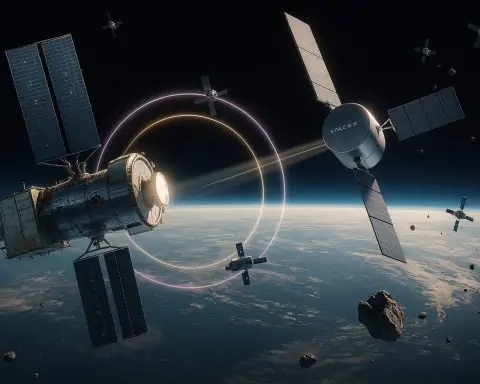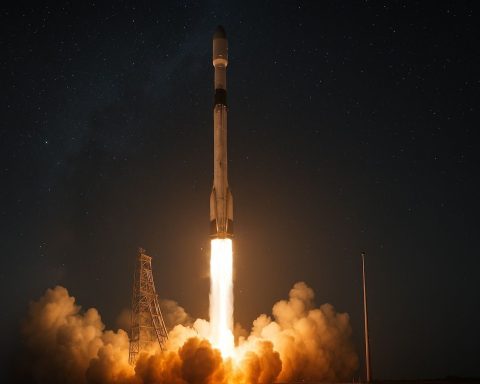Rocket Launch Triumphs: New Heavy-Lifters and Constellation Boosts
- ULA’s Vulcan Soars on Debut Military Mission: United Launch Alliance’s Vulcan Centaur rocket roared to life on Aug. 12, conducting its first Space Force-sanctioned mission [1]. Lifting off at 8:56 p.m. EDT from Cape Canaveral, Vulcan hauled a classified payload and an experimental Navigation Technology Satellite-3 (NTS-3) directly into geosynchronous orbit [2] [3]. This marked Vulcan’s third-ever launch (after two tests) and first certified flight for high-value national security satellites [4]. “This is the sole purpose of this vehicle. It was purposely designed to support these missions doing direct inject to GEO for the Space Force,” said ULA vice president Gary Wentz [5]. The NTS-3 experiment – America’s first new navigation satellite in nearly 50 years – will test jam-resistant GPS technologies using a phased-array antenna and in-orbit reprogrammable software [6] [7]. The mission is a milestone for ULA as Vulcan gradually replaces the Atlas V and Delta IV rockets, answering Congress’s call for an all-American launcher to end reliance on Russian engines [8]. Meanwhile, SpaceX’s launch cadence remains unrivaled, with 97 Falcon 9 missions flown in 2025 so far [9] – a dominance ULA aims to challenge as it ramps up Vulcan production.
- Europe’s Ariane 6 Delivers Next-Gen Weather Satellite: Just hours earlier, Europe’s new Ariane 6 heavy-lift rocket notched its third-ever flight on Aug. 12 [10]. Blasting off from Kourou, French Guiana, the Ariane 6 carried the 4-metric-ton MetOp-SG A1 satellite – an advanced polar-orbiting weather and climate observatory for EUMETSAT – into a 800 km polar orbit [11]. This MetOp Second Generation satellite, with its suite of six instruments including the Copernicus Sentinel-5 atmospheric sensor, will upgrade global monitoring of temperature, precipitation, winds, and air quality. “The satellite will take global observation of weather and climate from a polar orbit to a new level,” Arianespace noted of MetOp-SG A1’s capabilities, from tracking sea ice and soil moisture to volcanic dust and pollution [12]. Officials hailed the international effort behind the mission – a collaboration of ESA (development) and EUMETSAT (operations) – as crucial for better forecasts amid climate extremes. “The launch of MetOp-SG-A1 is a major step forward in giving national weather services…sharper tools to save lives, protect property, and build resilience against the climate crisis,” said EUMETSAT Director-General Phil Evans [13]. The success cements Ariane 6’s role as Europe’s workhorse following the retirement of Ariane 5, and demonstrates Europe’s commitment to continuity in Earth observation and global weather cooperation (this satellite is Europe’s first contribution to a joint polar weather system with NOAA) [14].
- Starlink Mission After Multiple Scrubs:SpaceX added yet more satellites to its Starlink internet constellation this week. A Falcon 9 launch from Vandenberg Space Force Base – originally planned for Aug. 9 – saw repeated delays due to weather and other factors [15], finally lifting off by Aug. 13 with 24 Starlink “V2 Mini” satellites bound for polar orbit. The booster, on its fifth flight, landed on the Of Course I Still Love You droneship shortly after liftoff, marking another flawless recovery. This mission underscores SpaceX’s breakneck tempo; the company has averaged nearly a launch every two days this year, extending Starlink’s reach. In fact, SpaceX announced Starlink service went live in new regions this month (e.g. Somalia and Israel) as it continues expanding coverage globally [16]. With over 7,500 Starlinks now in orbit and counting, SpaceX’s head start in the broadband mega-constellation race remains clear – even as competitors hustle to catch up.
- Amazon’s Kuiper Crosses 100-Satellite Milestone: SpaceX also lofted Amazon’s latest Project Kuiper batch this week, after four scrubbed attempts due to Florida thunderstorms [17] [18]. On Aug. 11, a Falcon 9 finally launched 24 Kuiper broadband satellites (mission KF-02) into low Earth orbit, bringing Amazon’s constellation to 102 satellites deployed so far [19]. This was the fourth Kuiper launch – the first two flew on ULA’s Atlas V in April and June, and the third on Falcon 9 in July – marking a major ramp-up as Amazon aims to start service later this year. The Kuiper craft separated at 465 km altitude and will raise themselves to ~630 km over coming months [20]. Amazon is investing heavily in launch infrastructure to accelerate deployment, including a new $140 million processing facility at Kennedy Space Center capable of handling three simultaneous launches [21]. With 3,200+ satellites planned in the initial Kuiper network, Amazon has inked launch contracts with Arianespace, Blue Origin, ULA, and SpaceX to support an unprecedented launch campaign [22] [23]. “Those agreements comprise the largest commercial procurement of launch capacity in history,” Amazon notes, as it strives to close the gap with SpaceX’s Starlink [24]. The successful deployment this week – despite earlier delays – puts over 100 Amazon satellites in orbit, a significant milestone as the global internet-in-space competition heats up [25].
Lunar Missions & Spaceflight Milestones: Moon Race Intensifies
- China Tests Lunar Lander, NASA Preps Artemis: The new space race to the Moon is on full display. On Aug. 6, China’s human spaceflight program conducted a key test of its next-gen crewed lunar lander, called “Lanyue” (“embrace the moon”) [26] [27]. The prototype’s ascent/descent engines were fired over a mock lunar surface in Hebei province, a “critical milestone” toward China’s goal of landing taikonauts on the Moon by 2030 [28]. The lander will ferry astronauts between lunar orbit and the surface, doubling as living quarters and a power/data hub on the Moon [29]. This rare public test announcement comes as Beijing accelerates its crewed lunar program – and as the United States aims to return. NASA’s Artemis program plans a crewed lunar fly-around in late 2025 or April 2026, and a landing (Artemis III) in 2027 [30]. U.S. officials are candid that they want to stave off China’s rapid advances [31]. Both nations view a Moon landing as strategic: China and Russia tout plans for an International Lunar Research Station by 2035 (with a nuclear-powered base) [32], while over 50 countries have joined NASA’s Artemis Accords framework for peaceful exploration. The lunar showdown is not just about flags and footprints, but establishing leadership in deep space. As one space analyst noted, “The disclosure about [China’s] test comes at a time when the United States is looking to stave off the rapid advances of China’s space program” [33] – underscoring that the Moon race is as much geopolitical as it is technical.
- Space Station Crew Returns and Next Missions Line Up: Back in low Earth orbit, a major crew rotation was recently completed. NASA’s Crew-10 astronauts (two NASA, one JAXA, one Roscosmos) departed the ISS on August 9 after a 146-day expedition [34]. The SpaceX Crew Dragon undocked and later splashed down off California’s coast, bringing the quartet safely home after five months. They returned with “important and time-sensitive research” samples from over 200 science experiments conducted in microgravity [35]. This wraps up a mission that began in March, when Crew-10 replaced Crew-9 on station. With Crew-10’s successful landing, NASA and SpaceX are turning to Crew-11, slated to launch in the coming weeks. NASA has been highlighting the new research heading up on Crew-11’s Dragon and a SpaceX CRS-33 cargo mission – from tissue-engineering experiments to tech demos for in-space data processing [36] [37]. These projects, including 3D-grown human tissues and on-orbit cloud computing trials, aim to pave the way for future long-duration missions. Additionally, international partnerships remain strong on the ISS: just last week a Russian Progress freighter delivered supplies, and a UAE astronaut onboard conducted science outreach. As NASA’s ISS director Heidi Parris noted in a briefing, “the research we send on each mission benefits humanity and prepares us for the Moon and Mars” [38] [39]. With the ISS now in its 25th year, plans for its successor are underway – but for now the orbital lab continues to serve as a crucible for cooperation, even amid terrestrial tensions.
Next-Gen Satellite Tech & Services: Innovation in Orbit
- Direct-to-Cell Satellite Messaging Debuts in Ukraine: A revolution in telecom from space is underway. Ukraine’s largest mobile carrier, Kyivstar, announced it successfully tested SpaceX’s Starlink “direct-to-cell” service – texting via satellite – in a field trial this week [40]. In the Aug. 12 test, engineers in rural Ukraine exchanged normal SMS messages on everyday smartphones, connected entirely through satellites rather than ground towers [41]. This marked the first such demo in Europe of Starlink’s direct-to-cell tech, which SpaceX has been quietly developing to eliminate cellular dead zones. Why it matters: In war-torn regions of Ukraine, Russian strikes often knock out infrastructure – so satellites can provide an “instant backup” network. Direct-to-cell aims to provide reliable connectivity when terrestrial networks are down, essentially turning satellites into “cell towers in space” that beam signals straight to phones [42]. The Starlink satellites involved carry special cellular base station payloads to communicate with standard 4G phones on the ground [43]. Telecom firms globally are eyeing similar capabilities to connect remote areas without building costly towers [44]. SpaceX has already signed direct-to-cell partnership deals with mobile operators in 10 countries and plans to roll out initial text messaging service by Q4 2025, expanding to voice and data in 2026 [45]. Ukraine’s government lauded the test – its digital minister sent one of the trial messages – seeing it as a lifeline for connectivity amid conflict. As one Kyivstar official put it, this tech could “provide a critical asset for war-torn Ukraine where Russian attacks on infrastructure regularly disrupt communications.” [46] Commercialization is next: Kyivstar and Starlink plan to offer direct-to-cell service to customers by the end of the year [47], an European first that could pave the way for truly ubiquitous coverage worldwide.
- DiskSats: Ultrathin Satellites Ready for Launch: The Aerospace Corporation is poised to launch the first-ever “DiskSats” – a radical new satellite form factor that is just 2.5 cm thick and disk-shaped [48]. Four DiskSat prototypes have completed prep and are scheduled to ride to orbit later this year (moved up to 2025 from 2026) as part of a NASA tech demo mission [49] [50]. Despite their pizza-box profile, DiskSats are designed to be highly maneuverable and capable, aiming to revolutionize very-low Earth orbit (vLEO) operations. “DiskSat is an exciting shift in small satellite development,” said principal scientist Catherine Venturini. “This demonstration is critical. If everything goes well, we anticipate a major increase in industry engagement — expecting a lot of phone calls.” [51] The appeal? In vLEO (300–450 km altitude), satellites can get sharper imagery and lower latency, and atmospheric drag naturally de-orbits debris quickly [52]. But traditionally, operating so low is hard due to drag and short lifetimes. DiskSats solve this by minimizing drag with their frisbee-like shape, using electric propulsion for station-keeping, and being cheap enough to replace frequently [53]. Their flat, symmetric design also packs and deploys efficiently – “You could bring your 20-satellite constellation up in one launch,” noted Aerospace’s Eric Breckheimer [54]. If the upcoming test proves successful, Aerospace plans to open-source or license DiskSat designs to spur commercial adoption [55]. The concept has generated buzz at the Small Satellite Conference in Utah this week, where researchers presented DiskSats as a potential “game-changer” for Earth imaging and space environmental safety (since satellites deorbit faster in vLEO, reducing long-term space junk) [56] [57]. The first four DiskSats will carry instruments to measure performance and orbital decay rates, helping validate this novel approach to satellites on a (literal) slim budget.
- Post-Launch Tracking: New Services to Find Your Satellite: As megaconstellations proliferate and rideshare launches send dozens of smallsats up at once, satellite operators face a tricky question after liftoff – which object is my satellite? This week, Texas-based launch services provider SEOPS (Spaceflight Engineering and Operations) unveiled a new solution: integrated post-launch tracking and identification services for its customers. Announced Aug. 11 at the SmallSat conference, SEOPS is partnering with Digantara – a space surveillance startup from India – to offer two months of free orbital tracking, spacecraft identification, and collision-avoidance data for all satellites it deploys [58] [59]. The service leverages Digantara’s growing network of ground radars and space-based sensors (the company launched a prototype SSA satellite earlier this year) to pinpoint tiny new satellites soon after they deploy [60]. Why it matters: On rideshare launches, it can take 24–48 hours (or more) for operators to identify which radar blip corresponds to their satellite and establish contact [61]. During that window, satellites may drift or even collide. “It’s unacceptable to us that in 2025, with all the tools and access available, operators are still forced to wait, struggle to make first contact, or operate in an elevated risk posture after launch,” said SEOPS CEO Chad Brinkley [62] [63]. By bundling Digantara’s tracking data into its launch packages, SEOPS aims to reduce risk from day one – giving operators immediate awareness of their satellite’s orbit and any potential conjunctions. After the initial free two-month period, customers can opt to continue the “Safety of Flight” service as a paid plan [64]. This move is a first for a launch provider, integrating space traffic management into launch ops. It highlights a broader trend: with congestion in low orbit, commercial players are stepping up with innovative space situational awareness (SSA) services. Even major satellite operators are taking notice – in a related deal announced at the conference, Telespazio (an Italian space company) said it will integrate Digantara’s data into its satellite control platform for customers, underscoring the demand for precise orbital tracking right after deployment. All of these efforts feed into making space operations safer and more efficient in the New Space era.
- Satellites Get Smarter: AI at the Edge – Another theme from the SmallSat expo was bringing artificial intelligence onboard satellites. Quebec-based Xiphos Technologies and U.S. startup ZAITRA announced a partnership to deliver edge AI processing solutions for smallsats, enabling spacecraft to analyze data in orbit instead of beaming everything to Earth. The companies are combining Xiphos’s radiation-tolerant flight computers with ZAITRA’s machine learning software to create “smart satellites” that can do things like real-time image recognition or anomaly detection on-board [65]. By processing data at the edge, satellites can send down only the insights or alerts that users need, rather than raw big data – critical for reducing bandwidth use and latency. This push for smarter, more autonomous satellites aligns with growing interest from both government and commercial operators in applications like on-orbit surveillance, adaptive communications networks, and even AI-driven satellite swarm coordination. While still in early stages, demos of in-space AI (such as a CubeSat that can identify ships in imagery, or one that uses AI to optimize its power usage) were hot topics at the conference. Industry analysts predict that “AI-on-a-satellite” could be as transformative as putting GPS in phones, unlocking new capabilities in remote sensing and beyond. With the ZAITRA–Xiphos team up, we may soon see small satellites that “think for themselves,” handling complex tasks on-site and heralding a new generation of intelligent space systems [66].
Space Policy & International Developments: Safety, Funding, and Collaboration
- Space Safety Gets a Boost – NASA Teams with LeoLabs: As Earth orbit grows crowded, space traffic management is taking center stage. NASA has signed a new Space Act Agreement with LeoLabs, a private company operating a network of ground-based space radars, to integrate LeoLabs’ high-resolution orbital debris data into NASA’s collision avoidance processes [67]. Announced Aug. 11, this partnership will allow NASA to evaluate whether commercial tracking info can enhance the agency’s existing Conjunction Assessment system for missions [68]. LeoLabs can track objects as small as 2 cm in low Earth orbit using phased-array radars in sites from Alaska to New Zealand. By tapping into that data, NASA hopes to improve warning time and accuracy for potential collisions involving its satellites and the International Space Station [69]. This comes as the U.S. government is shifting more responsibility for civil space traffic management to Commerce Department and commercial providers. LeoLabs CEO Dan Ceperley said the company is excited to demonstrate how its “orbital intelligence” can augment NASA’s tools in an era of proliferating small satellites and debris. Ultimately, better conjunction data means fewer evasive maneuvers and a lower risk of catastrophic collisions. The agreement highlights an emerging public-private approach to orbital safety, leveraging innovative startups to help protect everyone’s use of space. It also aligns with broader U.S. efforts to establish norms of behavior in space – a timely move, given recent incidents like Russia’s 2023 ASAT debris field and the sheer number of new satellites launching monthly.
- India Invests in Homegrown Satellites: In a significant commercial space initiative, India’s space regulator IN-SPACe announced on Aug. 12 that it has selected a consortium led by Bangalore-based startup Pixxel to build India’s first private Earth-imaging satellite constellation [70]. Backed by Google, Pixxel and partners (including startups Piersight, SatSure, and Dhruva Space) will receive over ₹12 billion (~$137 million) from the government to design, launch and operate a network of high-resolution Earth observation satellites over five years [71] [72]. The project is part of Prime Minister Modi’s drive for “Aatmanirbhar” (self-reliant) space capabilities [73]. By developing indigenous imaging satellites, India aims to reduce dependence on foreign data and services – much as it has with its own GPS-like NavIC navigation system [74]. The Pixxel-led bid beat out proposals from two major state-linked defense firms, signaling a big opportunity for India’s new space startups. Pixxel, notably, has already launched a few hyperspectral imaging microsatellites and forged analytics deals with Google Cloud. This new constellation will likely provide a wealth of remote-sensing data for agriculture, urban planning, disaster response and more, catered specifically to Indian needs. It also represents one of the largest public-private space investments in India’s history, following 2020 reforms that opened the Indian space sector to private players. IN-SPACe (Indian National Space Promotion and Authorization Centre) said the decision aligns with India’s goal to become a global hub for small satellites. With ISRO’s rockets and potentially privately built launchers carrying these future satellites, India is stitching together an end-to-end domestic space ecosystem. Observers note that India’s move comes as other nations also push for sovereign space infrastructure – and could position Indian companies to compete internationally in the booming Earth observation market.
- International Cooperation and Competition: Around the world, collaboration and rivalry in space continue in tandem. Russia and China’s lunar alliance garnered attention with China’s lander test, as the duo invite countries like Pakistan and Thailand to join their planned Moon base [75] – a counter to the U.S.-led Artemis coalition. Europe, for its part, demonstrated cooperative strength in the successful MetOp-SG weather satellite launch, which involved 15 nations and agencies working together [76]. The Artemis Accords tally keeps growing (most recently signed by Germany and Argentina), underscoring a diplomatic push for shared principles on moon exploration. Meanwhile, NASA and Canada are deepening ties on Artemis II (with a Canadian astronaut slated to fly around the Moon in 2025), and Japan’s space agency JAXA just received cabinet approval for a ~$4 billion budget that includes a new H3 rocket and a lunar lander project, reflecting its commitments to both Artemis and its own missions. In the commercial arena, the U.S. Senate’s recent budget draft safeguarded funding for NASA science and Artemis despite proposed cuts, signaling bipartisan recognition of space’s strategic importance [77] [78]. And in a poignant moment of reflection amid the progress, the space community mourned Apollo legend Jim Lovell, who passed away at 97 on Aug. 8 [79]. Lovell’s legacy – from the first Moon orbit to the famous “Houston” problem-solving of Apollo 13 – is a reminder of how far space exploration has come and the spirit of international teamwork it continues to inspire. As we’ve seen over these two days, the global space sector is firing on all cylinders: new rockets launching, new alliances forming, and a new generation of technology transforming how we use the final frontier.
Sources: Spaceflight Now [80] [81] [82]; Space.com [83] [84]; Space & Defense [85]; Reuters [86] [87]; Space.com (B. Tingley) [88] [89]; Space.com (M. Wall) [90] [91]; Spaceflight Now [92]; Reuters (Kyivstar/Starlink) [93] [94]; Aerospace Corp. [95] [96]; Via Satellite [97]; Keeptrack Brief [98] [99]; Slashdot/Reuters (Crew-10) [100] [101].
References
1. spaceflightnow.com, 2. spaceflightnow.com, 3. spaceflightnow.com, 4. spaceflightnow.com, 5. spaceflightnow.com, 6. www.space.com, 7. www.space.com, 8. spaceflightnow.com, 9. spaceflightnow.com, 10. www.space.com, 11. www.space.com, 12. www.space.com, 13. spaceanddefense.io, 14. spaceanddefense.io, 15. spaceflightnow.com, 16. spaceflightnow.com, 17. www.advanced-television.com, 18. www.advanced-television.com, 19. www.advanced-television.com, 20. www.advanced-television.com, 21. www.advanced-television.com, 22. www.space.com, 23. www.space.com, 24. www.space.com, 25. www.advanced-television.com, 26. www.reuters.com, 27. www.reuters.com, 28. www.reuters.com, 29. www.reuters.com, 30. www.reuters.com, 31. www.reuters.com, 32. www.reuters.com, 33. www.reuters.com, 34. science.slashdot.org, 35. science.slashdot.org, 36. issnationallab.org, 37. issnationallab.org, 38. issnationallab.org, 39. issnationallab.org, 40. www.reuters.com, 41. www.reuters.com, 42. www.reuters.com, 43. www.reuters.com, 44. www.reuters.com, 45. www.reuters.com, 46. www.reuters.com, 47. www.reuters.com, 48. aerospace.org, 49. aerospace.org, 50. aerospace.org, 51. aerospace.org, 52. aerospace.org, 53. aerospace.org, 54. aerospace.org, 55. aerospace.org, 56. aerospace.org, 57. aerospace.org, 58. www.satellitetoday.com, 59. www.satellitetoday.com, 60. www.satellitetoday.com, 61. www.satellitetoday.com, 62. www.satellitetoday.com, 63. www.satellitetoday.com, 64. www.satellitetoday.com, 65. keeptrack.space, 66. keeptrack.space, 67. keeptrack.space, 68. starfightersspace.com, 69. keeptrack.space, 70. www.reuters.com, 71. www.reuters.com, 72. www.reuters.com, 73. www.reuters.com, 74. www.reuters.com, 75. www.reuters.com, 76. spaceanddefense.io, 77. www.scientificamerican.com, 78. www.scientificamerican.com, 79. spaceflightnow.com, 80. spaceflightnow.com, 81. spaceflightnow.com, 82. spaceflightnow.com, 83. www.space.com, 84. www.space.com, 85. spaceanddefense.io, 86. www.reuters.com, 87. www.reuters.com, 88. www.space.com, 89. www.space.com, 90. www.advanced-television.com, 91. www.advanced-television.com, 92. spaceflightnow.com, 93. www.reuters.com, 94. www.reuters.com, 95. aerospace.org, 96. aerospace.org, 97. www.satellitetoday.com, 98. keeptrack.space, 99. keeptrack.space, 100. science.slashdot.org, 101. science.slashdot.org










